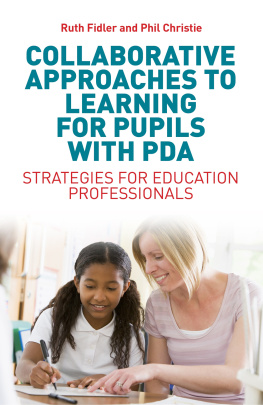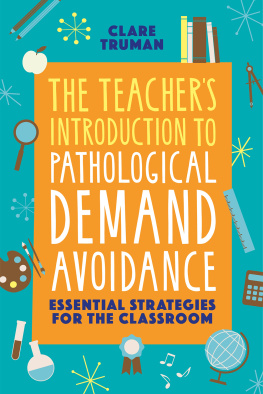
COLLABORATIVE
APPROACHES TO
LEARNING FOR
PUPILS WITH PDA
Strategies for Education Professionals
RUTH FIDLER
and PHIL CHRISTIE

Jessica Kingsley Publishers
London and Philadelphia
Contents
INTRODUCTION
As we were in the process of writing this text a report was published by the All Party Parliamentary Group on Autism (APPGA 2017) on how the education system works for children and young people on the autism spectrum. This report was highly critical of the experience provided for many children, young people and their families in terms of getting an appropriate assessment and finding the right school place. It described how, for some children, their educational experience becomes a pathway for failure (p.31). The report found that fewer than half of children with autism said they were happy at school and that the same number said that their teachers didnt know how to support them. The recommendations included that autism understanding should be embedded in the education system and that there should be a specialist curriculum for all pupils who need one.
The focus of this book is on a group of children who may fit the profile described as pathological demand avoidance (PDA), which is now widely understood to be a profile within the autism spectrum. The book is intended for educational practioners who might be working with children across different ages and in the full range of educational settings. Our own experience has been developed from working within and leading a specialist autism provision, from providing training and consultancy in connection with pupils in diverse provisions and from working with parents who are often struggling to find the best way to widen educational opportunities and experiences for their children.
What this experience has underlined for us is that there are a number of children who have these complex difficulties in social understanding, communication and behaviour who seem to need more flexibility and negotiation, and a less direct style than is typically the case with other children on the autism spectrum.
The children who need this more collaborative approach to learning and teaching typically have very high levels of anxiety and find it hard to tolerate the demands and expectations of other people. They are also often adept at avoiding these perceived demands and are controlling of other people and aspects of their environment. They may have received a diagnosis that includes a reference to pathological demand avoidance or a demand avoidant profile. They may, though, not have received this sort of diagnosis but be displaying a behavioural profile that resonates with parents or teachers who have come across accounts of PDA.
Throughout the book there are examples given from our work with children and young people with PDA and their families and schools. Most of these will have come from assessments carried out at the Elizabeth Newson Centre or when we were involved as school leaders at the associated specialist school for children with autism. Others have been taken from our subsequent consultancy work. All examples have been anonymised. Templates of the forms used can be downloaded at www.jkp.com/catalogue/book/9781785920172 for use in your own assessments.
We are particularly grateful for the help provided by Suzanne Farrell, who is our colleague at Autism Associates with a background in curriculum and assessment. Suzanne has made a significant contribution to which reflect those issues.
Chapter 1
TOWARDS AN
UNDERSTANDING OF PDA
This book is not intended to give a full account of the continuing debate, discussion and controversies that exist around the PDA profile and where precisely it fits within the systems of diagnostic classification. Those who are interested in thinking about this further can follow up through the references given for this chapter. It is, though, helpful to have a short overview of the clinical and research developments that have contributed to an emerging understanding of the characteristic diagnostic profile and the issues that have arisen from this work.
Pathological demand avoidance (PDA) was a term first used by Professor Elizabeth Newson in the early 1980s. The initial descriptions of this profile were introduced in a series of lectures, presentations and papers that described a gradually developing understanding of a group of children who had been referred for diagnostic assessment at the clinic she led at the Child Development Research Unit of Nottingham University. Most of the children referred to the clinic were complex and unusual in their developmental profile and many reminded the referring professionals of children with autism or Asperger syndrome. At the same time, though, they were often seen as atypical in some ways.
Newson, and the colleagues she worked with, felt increasingly dissatisfied with the description of atypical autism, a term that was used quite widely at the time. They felt that it was not particularly helpful in removing the confusion that was often felt by parents and teachers who were struggling to gain greater insight into the childs behaviour. As time went by, it became apparent that, while these children were indeed atypical of the understandings of autism or Asperger syndrome at the time, they were very similar to each other in some very important ways. The central feature that was characteristic of all the children was an obsessional avoidance of the ordinary demands of everyday life (Newson, Le Marechal and David 2003, p.596). This was combined with sufficient social understanding and sociability to enable the child to be socially manipulative in their avoidance. Newson proposed that PDA should be seen as a separate syndrome within the Pervasive Developmental Disorders (p.596), which was the recognised category used within the versions of the psychiatric classification systems that were current at the time (ICD-10, World Health Organization 1992, and DSM-IV, American Psychiatric Association 1994).
Newsons work on PDA attracted great interest as well as a degree of controversy. This continues to be the case today. At the centre of the interest has been the strong sense of recognition, expressed by both parents and professionals, of the developmental and behavioural profile that she so clearly described. Parents, in particular, recounted a light bulb moment on reading the accounts and a feeling that they were, at last, hearing a description that seemed to make sense of their child. The controversy that arose was about whether PDA existed as a separate syndrome within the pervasive developmental disorders or whether the behaviours could be explained within other diagnostic categories. This debate continues today and research carried out over the last few years is helping to clarify the situation.
In the years following Newson et al. s 2003 publication, the first paper on PDA to appear in a peer-reviewed journal, it became apparent that the term autism spectrum disorder (ASD) was being used as though it was the same as pervasive developmental disorder. In fact, the National Autism Plan for Children, also published in 2003, talked about the term ASD broadly coinciding with the term Pervasive Developmental Disorder (p.16). The more recently published National Institute for Health and Clinical Excellence (NICE) guidelines on autism spectrum disorders (2011) described the two terms as being synonymous.
The importance of this is that PDA is now widely considered to be part of the autism spectrum, or one of the autism spectrum conditions. This view was endorsed when the National Autistic Society (NAS) updated their website in 2015 to include information about PDA as a profile within the autism spectrum (NAS n.d.).
Next page











